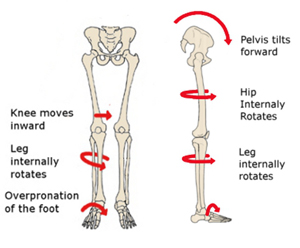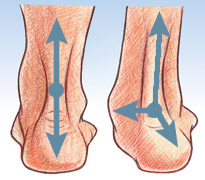Repetitive activity, especially when deconditioned, is a frequent cause of soreness or pain. Usually, with some rest and gradual return to the activity, the soreness will not return and your conditioning can continue to progress. A pain that continues to occur with the activity, like running, becomes a sign that something is not functioning right.
 When we see runners, most injuries are consistently related to a baseline excessive pronation when the foot is on the ground. While there are shoes that purport to control or maybe alleviate this, the forces of the body and interworking lower extremity joints cause an increase internal rotation of the tibia and femur. This leads to many “injuries” or signs that something is wrong. The patella can be seen tracking lateral and be a site of “patello-femoral pain”, the internal rotation of the leg can tension the Iliotibial band and be a source of knee and/ or hip pain. Medial lower leg pain and even low back pain can all arise as a result of the excessive pronation.
When we see runners, most injuries are consistently related to a baseline excessive pronation when the foot is on the ground. While there are shoes that purport to control or maybe alleviate this, the forces of the body and interworking lower extremity joints cause an increase internal rotation of the tibia and femur. This leads to many “injuries” or signs that something is wrong. The patella can be seen tracking lateral and be a site of “patello-femoral pain”, the internal rotation of the leg can tension the Iliotibial band and be a source of knee and/ or hip pain. Medial lower leg pain and even low back pain can all arise as a result of the excessive pronation.
 Pronation in running is usually also, not a solo event, but the result of lower leg forces of running maybe too much to control and less so in normal gait. Normal walking and standing postures and accommodated weakness can begin you on the path to leg pain and/or injury.
Pronation in running is usually also, not a solo event, but the result of lower leg forces of running maybe too much to control and less so in normal gait. Normal walking and standing postures and accommodated weakness can begin you on the path to leg pain and/or injury.
A start is to notice the progression of the foot pressure from heel strike to toe off. Are you using the big toe? Begin to try and move towards the 2nd and 3rd toes.
This centralized pressure is provided or maintained by the calf and lower leg muscles when functioning properly.



